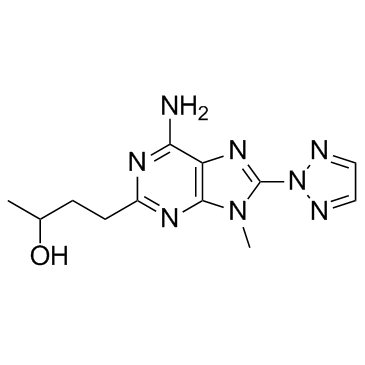| Description |
ST3932 is a metabolite of ST1535, acts as an antagonist of adenosine A2A receptor, with Kis of 8 nM and 33 nM for A2A and A1 receptors, respectively.
|
| Related Catalog |
|
| Target |
Ki: 8 nM (A2A receptor), 33 nM (A1 receptor)[1]
|
| In Vitro |
ST3932 is a metabolite of ST1535, acts as an antagonist of adenosine A2A receptor, with Kis of 8 nM and 33 nM for A2A and A1 receptors, respectively. ST3932 inhibits agonist-induced cAMP accumulation with an IC50 value of 450 nM[1].
|
| In Vivo |
ST3932 (10, 20, 40 mg/kg, p.o.) antagonizes haloperidol-induced catalepsy, and increases motor activity in mice. ST3932 (20, 40 mg/kg, i.p.) significantly increases the number of contralateral turns induced by l-DOPA in rats[1].
|
| Animal Admin |
Mice[1] Catalepsy is induced by haloperidol (2 mg/kg) injected intraperitoneally (i.p.) 2.5 h before oral administration of 10, 20, and 40 mg/kg ST1535, ST3932, ST4206 or vehicle. An additional group without haloperidol (control group) with only vehicle is administered. At time 0 min, successful induction of catalepsy in all animals is checked before compounds administration, then, catalepsy is scored every 60 min for 3 h. Each mouse is gently placed by its forepaws on a wire at a height of 4.5 cm. The catalepsy is measured as the time necessary for the animal to step down with at least one forepaw with a cut off time for each animal of 60 s; after this time the mouse is gently removed from the wire. Catalepsy is recorded using a video-camera and by an observer who is unaware of the treatment[1]. Rats[1] Two weeks after the unilateral 6-OHDA-lesion, rats are screened on the basis of their contralateral rotation in response to l-DOPA (50 mg/kg i.p.)+benserazide (30 mg/kg i.p.). Rats not showing at least 200 contralateral rotations during 3 h testing period are eliminated from the study. One week later, rats are administered with the threshold dose of l-DOPA (3 mg/kg i.p.)+benserazide (6 mg/kg i.p.) in combination with vehicle (10% sucrose and 0.3% Tween 80 in sterile water i.p.) or with ST1535, ST3932 and ST4206 respectively (10, 20 and 40 mg/kg i.p.). l-DOPA is administered 5 min after vehicle or molecules in study, whereas benserazide is administered 30 min before l-DOPA injection. Contralateral rotations are measured every 10 min for 2 h by Rotameter system[1].
|
| References |
[1]. ST3932, et al. Animal models of Parkinson׳s disease: Effects of two adenosine A2A receptor antagonists ST4206 and ST3932, metabolites of 2-n-Butyl-9-methyl-8-[1,2,3]triazol-2-yl-9H-purin-6-ylamine (ST1535). Eur J Pharmacol. 2015 Aug 15;761:353-61.
|
